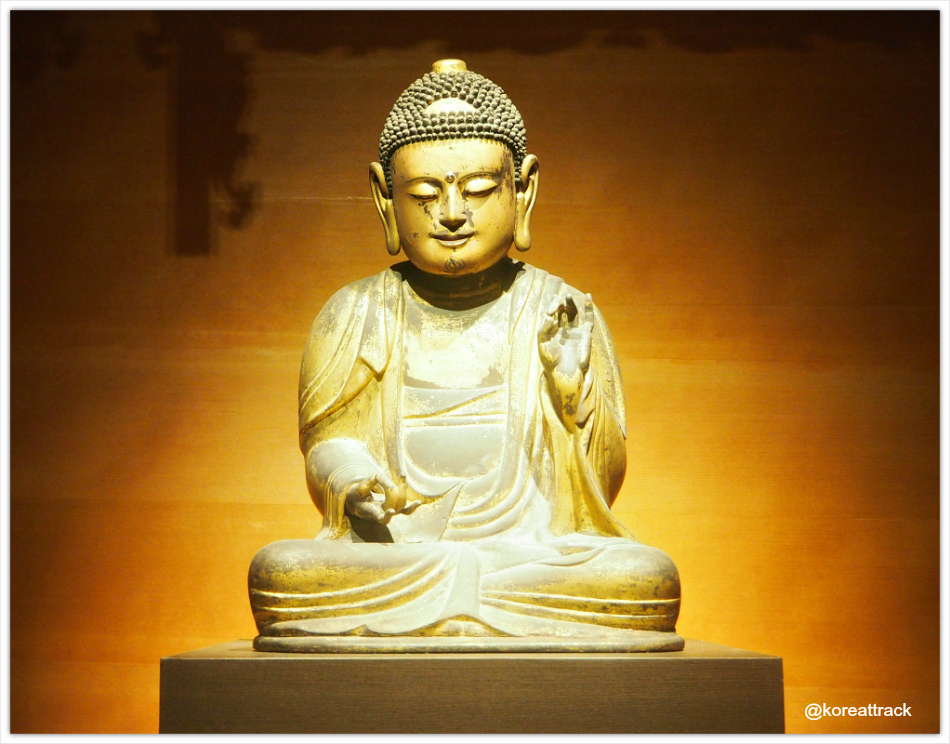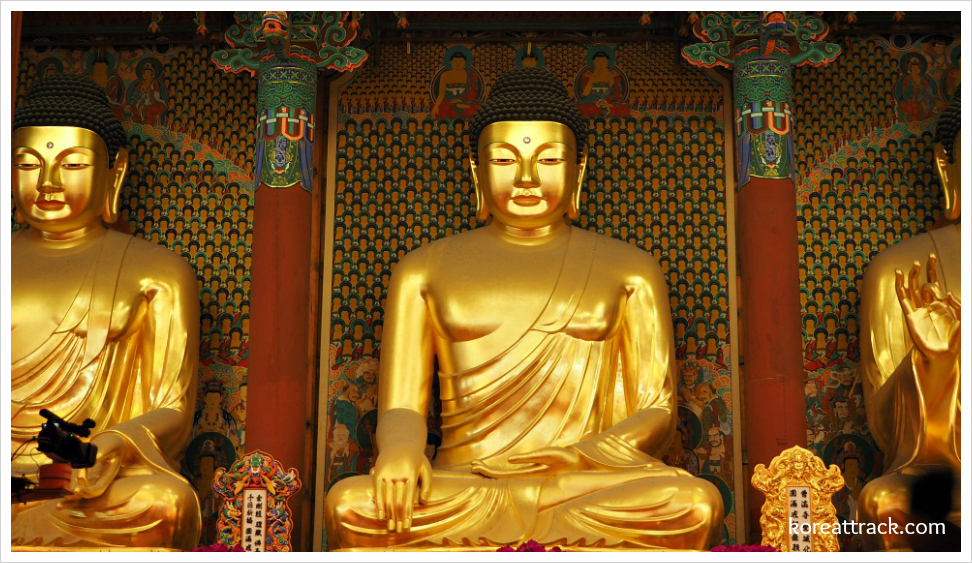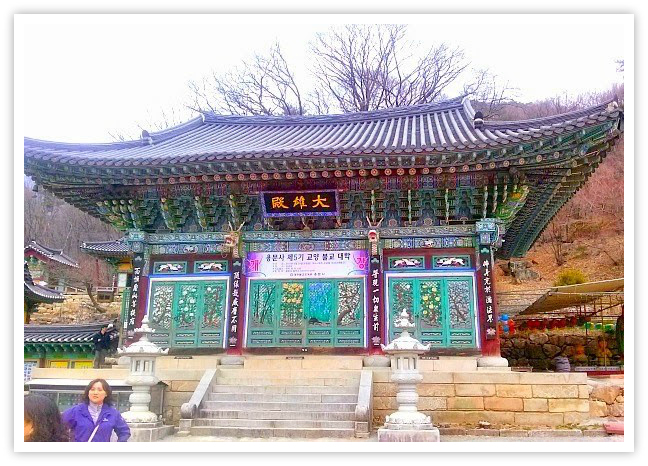Bogyeongsa Temple
In Pohang City
 Bogyeongsa Temple in Pohang (photo:Song Min Young)
Bogyeongsa Temple in Pohang (photo:Song Min Young)Bogyeongsa Temple in Pohang
Welcome to the land of beauty, where history and nature blend seamlessly to create a breathtaking landscape.
Today, we take you on a journey to discover the hidden gem of Gyeongsangbuk-do, the Bogyeongsa Temple in Pohang City.
Nestled in the northern part of Pohang, this mystical temple is surrounded by verdant mountains and offers a serene haven for those seeking peace and tranquility.
With its rich history, stunning architecture, and awe-inspiring scenery, Bogyeongsa Temple is a must-visit destination for travelers worldwide.
So, pack your bags, and let's embark on this unforgettable adventure together!
History of Bogyeongsa Temple
 Gate to the temple area - an architectural style particularly in the Joseon period. The gate has only two main columns supporting the whole roof.
Gate to the temple area - an architectural style particularly in the Joseon period. The gate has only two main columns supporting the whole roof.Bogyeongsa Temple is located in southeastern South Korea, on the slopes of Mt. Naeyeonsan in Pohang.
Its long and rich history dates back to 603 A.D. when the monk Jimyeong first built it during the reign of King Jinpyeong of Silla.
According to the legend, upon his return to the Silla Kingdom from studying in Tang China, Jimyeong instructed King Jinpyeong of Silla to build a Buddhist temple on a famous mountain on the east coast.
He told the king that burying Palmyeong-bogyeong (scripture) in an auspicious site on that mountain would prevent Japanese pirates from invading the Silla Kingdom and allow him to unify the Three Kingdoms.
The king was pleased with this idea and traveled north along the coast of Pohang, where he saw a mountain covered with clouds with five colors. That mountain was Mt. Naeyeonsan, and it was there that the king founded Bogyeongsa Temple.
Due to fires and invasions, the temple complex has undergone many changes and renovations over the years. However, it still retains its traditional architecture, and many buildings have been designated national treasures.
The temple is surrounded by beautiful natural scenery, including a lotus pond that King Jinpyeong filled in during its construction.
 Two of the 13 waterfalls in the Naeyeonsan Mountain area.
Two of the 13 waterfalls in the Naeyeonsan Mountain area.Today, Bogyeongsa Temple is a popular destination for tourists and pilgrims who enjoy the peaceful atmosphere and stunning surroundings.
Visitors can see the oldest stone pagoda in Korea, which dates back to the 7th century, and many other cultural and religious relics.
The temple also offers various meditation and temple stay programs, where visitors can experience the traditional way of life and learn about Buddhist culture and teachings.
The name of the temple comes from this founding myth. "Bogyeong," in English, means scripture. So the name of Bogyeongsa Temple means "Scripture Temple," in English.
Purportedly, these very same scriptures that King Jinpyeong of Silla buried at Bogyeongsa Temple are now buried under the historic Jeokgwang-jeon Hall.
Bogyeongsa Temple Treasures
 An ancient 5-storey stone pagoda at Bogyeongsa Temple in Pohang
An ancient 5-storey stone pagoda at Bogyeongsa Temple in PohangSince its establishment, Bogyeongsa Temple in Pohang has held many Buddhist items. Due to their historical and religious values, they are considered treasures and part of the national Korean heritage.
The items below are considered the top treasures worth seeing when visiting the temple area.
Bronze Bell
This Buddhist bronze bell was made by Sain, a well-known Buddhist monk and craftsman, during the first half of the 18th century in the Joseon Dynasty.
Sain practiced in Gyeonggi-do and Gyeongsang-do provinces and infused genuine originality into ancient Silla's traditional bell-casting process.
This bell is Sain's earliest production, with a round loop on the top to enable its suspension. The shoulder of the bell is surrounded by forty standing lotus petals, each bearing a human figure.
Below these petals are four square-shaped frames, and in each frame, there are five protruded dots, which mark a departure from the typical configuration of nine dots.
Between the squares, Buddha's teachings are inscribed. Despite its small size, this bell is representative of Sain's earlier production technique and is an essential resource for studies of the bells of the Joseon Dynasty.
Stele of State Preceptor Wonjin
The Stele of State Preceptor Wonjin is a memorial stone located in the precinct of the Bogyeongsa Temple, dedicated to a great Buddhist monk named Wonjin from the Goryeo Dynasty.
Wonjin was born in 1171 and became a monk at the age of 13, eventually becoming the head monk of the temple.
He was given the posthumous title of Wonjin and the rank of State Preceptor by King Gojong of Goryeo after his death at 51.
The memorial stone has a unique design, with the top corners rounded off and the base carved into the shape of a tortoise with the Chinese character for "king" inscribed on each shell.
The epigraph on the memorial stone was composed by Yi Gong-ro and written by the famous calligrapher Kim Hyo-in. The stone was made in 1224, three years after Wonjin's death.
The Stupa of Bogyeongsa Temple
The Stupa of Bogyeongsa Temple is located halfway up the mountain in Pohang.
It enshrines the sarira of State Preceptor Wonjin, a Buddhist monk during the mid-Goryeo Dynasty.
The stylobate of the stupa consists of three-layered octagonal stones with engraved lotus flower and pillar patterns. The main body of the stupa resembles a stone pillar and has a lock design on one surface.
The final, resembling an over-turned bowl, is placed on a supporting stone resembling a full-blown lotus flower.
The stupa was erected in the general style of octagonal stupas but seems disproportionately long, exhibiting a plain and straightforward style.
Hanging Painting of Bogyeongsa Temple
The Buddhist painting of Bogyeongsa Temple was created in 1708 and re-painted in 1725 by a group of painters based in Gyeongsang-do, including Uigyun, Seokmin, Seongik, Jibung, Chehwan, Kwaemin, and Samhak.
This masterpiece portrays a Bodhisattva-style Buddha, holding a lotus stem, adorned with intricate details such as green design motifs on the gold-painted sash of Buddha's robe and delicate motifs at the bottom edge of the robe.
This work is considered the greatest masterpiece of Uigyun and can shed light on the history and evolution of Joseon Buddhist paintings.
 Bogyengsa Temple in Pohang and watercolor painting [photo: Pit Nal Lee]
Bogyengsa Temple in Pohang and watercolor painting [photo: Pit Nal Lee]Jeokgwangjeon Hall of Bogyeongsa Temple
The Jeokgwangjeon Hall of Bogyeongsa Temple, located in Pohang, is a structure that measures three kan by two kan. It has a simple gable roof supported by multiple clusters of decorative brackets.
The hall enshrines a Vairocana statue and features stone column bases and fillers typical of Unified Silla architecture.
Additionally, the gateposts are supported by stone bases that hint at using materials from the original Silla structure during the hall's restoration.
The wooden bases in the lower front of the hall are adorned with intricately carved lions. The decorative brackets arranged along the eaves exhibit late seventeenth-century characteristics, while the exposed-rafter ceiling gives the building its unique style.
(Note: Kan is a unit of measurement that refers to the distance between two columns.)
Painting of Vairocana Buddha of Bogyeongsa Temple
The Vairocana Buddha of Bogyeongsa Temple in Pohang was created in 1742 by three monk-artists.
The painting depicts Buddhist deities with fine white lines against a red background on a large hemp cloth.
Vairocana Buddha is surrounded by a group of attendants and followers, including Samantabhadra and Manjsri Bodhisattvas, as well as the Four Heavenly Kings.
This altarpiece is one of the earliest devoted to Vairocana Buddha in Korea, and its elaborate brushstrokes, decorative designs, precise production date, and artists make it a valuable source for studying Buddhist iconography during the late Joseon period.
Features of Bogyeongsa Area
 Twin waterfalls on Naeyeonsan Mountain, where Bogyeongsa Temple is nestled. (photo: Youn Keun Roh)
Twin waterfalls on Naeyeonsan Mountain, where Bogyeongsa Temple is nestled. (photo: Youn Keun Roh)Picturesque Landscape: Bogyeongsa temple is known for its serene and picturesque landscape surrounding the temple grounds.
The temple is at the foot of Naeyeonsan Mountain, and the 13 beautiful waterfalls that flow from the mountain create a peaceful and tranquil environment.
Visitors to the temple can enjoy the stunning natural scenery and walk along the mountain path to experience a closer connection with nature.
One of Bogyeongsa temple's notable features is the historic Wontong-jeon Hall, a symbol of the temple's enduring spirit.
The hall has been standing for centuries and is considered a cultural heritage site. Visitors can explore the hall and learn about the rich history and culture of the temple and the region.
Another significant feature of the temple is the Giyeong-gak Hall, a place of prayer and gratitude that honors kings and their lineage.
The hall is beautifully decorated with traditional Korean art and is a must-visit spot for those interested in Korean history and culture.
Visitors can experience a sense of peace and serenity while inside the hall and connect with the region's rich cultural heritage.
Attractions & Hikes
 One of the 13 waterfalls of Naeyeonsan [photo: Pit Nal Lee]
One of the 13 waterfalls of Naeyeonsan [photo: Pit Nal Lee]Are you ready to take on the challenge of hiking up Naeyeon-san? At 930 meters high, this mountain is an actual test of your hiking skills and endurance.
As you make your ascent, you'll be surrounded by stunning waterfalls cascading down the hill and the beauty of the valley below. The hike up Naeyeon-san offers spectacular views that are well worth the effort.
You'll feel the burn in your muscles as you climb higher and higher, but the feeling of accomplishment when you reach the summit is indescribable.
So, if you're up for an adventure and want to witness breathtaking views from the top of Naeyeon-san, lace up your boots and get ready for an unforgettable hike!
Getting to Bogyeongsa Temple in Pohang
From the Pohang Intercity Bus Terminal, you'll find a bus stop where Bus #510 – 보경사 (Bogyeongsa) passes. This bus goes to Bogyeongsa Temple.
However, this bus shouldn't be confused with other Bus #510s. Only take the one that reads "Bogyeongsa" on it. This bus ride should take about an hour and leave every hour.
Whether you seek spiritual solace, cultural exploration, or wish to immerse yourself in nature's beauty, Bogyeongsa Temple invites you to discover the echoes of centuries past. 🏯
Enjoy your journey, and thanks for reading!
- Home
- Temples in South Korea
- Bogyeongsa Temple In Pohang
Get Exciting Activities
Book one of our exciting activities today to experience the thrill of a lifetime! Take advantage of this opportunity and secure your spot in advance.
Hotel Map Guide
Find your affordable, accessible, and comfortable hotel in Seoul at Agoda.Com. See the hotel map below...
Hotel Booking Guide
Find affordable and amazing hotels on Agoda.com using the search box below. Book now to enjoy great discounts and save!







New! Comments
What do you think about this page? Leave me a comment in the box below.